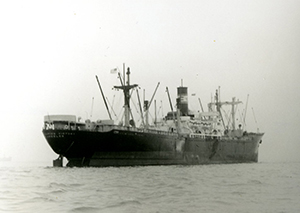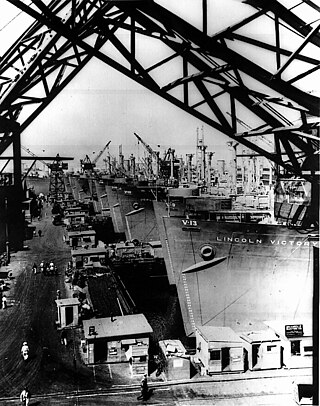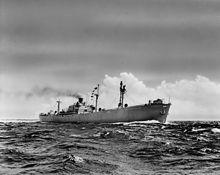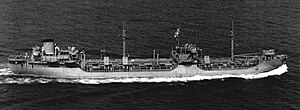
The Victory ship was a class of cargo ship produced in large numbers by American shipyards during World War II to replace losses caused by German submarines. They were a more modern design compared to the earlier Liberty ship, were slightly larger and had more powerful steam turbine engines, giving higher speed to allow participation in high-speed convoys and make them more difficult targets for German U-boats. A total of 531 Victory ships were built in between 1944 and 1946.

The SS Lindenwood Victory was a Victory-class cargo ship built during World War II. The Lindenwood Victory was a type VC2-S-AP2 victory ship built by Permanente Metals Corporation, Yard 2, of Richmond, California. The Maritime Administration cargo ship was the 766th ship built. Her keel was laid on May 12, 1945. SS Lindenwood Victory was an armed cargo ship She was built in just 70 days, under the Emergency Shipbuilding program for World War II. SS Lindenwood Victory was an armed cargo ship, named for Lindenwood University in St. Charles, Missouri, one of 150 educational institutions that had Victory ships named after them. The 10,600-ton ship was constructed for the Maritime Commission.

SS Mercer Victory was a Boulder Victory-class cargo ship built for World War II. Mercer Victory, a Victory ship, was launched 14 March 1945 by Permanente Metals Corporation, Richmond, California and operated by the States Marine Line. At the ceremonial ship launching, Mercer University President Spright Dowell said the SS Mercer Victory should strive: “to do her full-part for the national defense” and “to study a plan for after war conditions and needs.”

The SS Carroll Victory was the twenty-seventh Victory ship built during the World War II under the Emergency Shipbuilding program. shewas launched by the California Shipbuilding Company on June 13, 1944, and completed on August 31, 1944. The ship was named after Carroll, Iowa. The ship’s United States Maritime Commission designation was VC2-S-AP3 with a hull number 27 (V-27). shewas operated by the Lykes Brothers Steamship Company and sheserved in the Atlantic Ocean during World War II. The Carroll was one of the new 10,500-ton class ship known as Victory ships that were designed to replace the earlier Liberty Ships. Unlike Liberty ships, Victory ships were designed to last longer and serve the US Navy after the war. The Victory ships differed from Liberty ships in that they were faster, longer and wider, taller, had a thinner stack set farther toward the superstructure, and had a long raised forecastle.

The SS Clovis Victory was the thirty-second Victory ship built during World War II, in 156 days under the Emergency Shipbuilding program. She was launched by the California Shipbuilding Company on June 13, 1944 and completed on August 31, 1944. The ship's United States Maritime Commission designation was VC2- S- AP3, hull number 27, operated by Seas Shipping Company. SS Clovis Victory served in the Pacific Ocean. Victory ships were designed to replace the earlier Liberty ships. Liberty ships were designed to be used just for WW2. Victory ships were designed to last longer and serve the US Navy after the war. The Victory ship differed from a Liberty ship in that they were: faster, longer and wider, taller, had a thinner stack set farther toward the superstructure, and had a long raised forecastle. The sponsor of the Clovis Victory was the wife of the 200th Coast Artillery's Henry Max Miller of Clovis, New Mexico. Major Miller was lost in the sinking of the SS Shinyō Maru on September 7, 1944.

SS Cedar Rapids Victory was the 77th Victory ship built during World War II under the Emergency Shipbuilding program. She was launched by the California Shipbuilding Company on January 14, 1945, and completed on February 17, 1945. The ship’s United States Maritime Commission designation was VC2-S-AP3 and her hull number was 77. Her operator was the American West African Line.

SS Hobbs Victory was a cargo Victory ship built for World War II under the Emergency Shipbuilding program. Hobbs Victory, was launched on January 9, 1945 by Permanente Metals Corporation, Richmond, California and completed on January 9, 1945. She was built in just 87 days. She was operated by the Sudden & Christenson for the United States Maritime Commission.

The SS Joplin Victory was the 12th Victory ship built during World War II under the Emergency Shipbuilding program. She was launched by the California Shipbuilding Company on April 25, 1944 and completed on June 15, 1944. The ship's United States Maritime Commission designation was VC2-S-AP3, hull number 12 (V-12). The 10,500-ton Victory ships were designed to replace the earlier Liberty Ships. Liberty ships were designed to be used just for World War II. Victory ships were designed to last longer and serve the US Navy after the war. The Victory ship differed from a Liberty ship in that they were: faster, longer and wider, taller, had a thinner stack set farther toward the superstructure and had a long raised forecastle.

The SS Gainesville Victory was the 22nd Victory ship built during World War II under the Emergency Shipbuilding program. She was launched by the California Shipbuilding Company on June 9, 1944, and completed on July 22, 1944. The ship’s United States Maritime Commission designation was VC2-S-AP3, hull number 22 (V-22). She was operated by the Seas Shipping Company. SS Gainesville Victory served in the Pacific Ocean during World War II. SS Gainesville Victory was number one of the new 10,500-ton class of ships, known as Victory ships. Victory ships were designed to replace the earlier Liberty Ships. Liberty ships were designed to be used just for WW2, while Victory ships were designed to last longer and serve the US Navy after the war. The Victory ships differed from the Liberty ships in that they were faster, longer, wider, taller, had a thinner stack set farther toward the superstructure, and had a long raised forecastle.

SS Frontenac Victory was a Victory ship built for the United States War Shipping Administration late in World War II under the Emergency Shipbuilding program. It saw service in the European Theater of Operations in the Atlantic Ocean during 1945, and in the immediate post-war period. SS Frontenac Victory was part of the series of Victory ships named after cities; this particular ship was named after the city of Frontenac, Missouri. It was a type VC2-S-AP2/WSAT cargo ship with the U.S. Maritime Commission (MARCOM), "Victory" (MCV) hull number 625, shipyard number 1597, and built by Bethlehem Shipbuilding Corporation in Baltimore, Maryland.

The SS Bucknell Victory was a Victory-class cargo ship built during World War II. The Bucknell Victory was a type VC2-S-AP2 victory ship built by Permanente Metals Corporation, Yard 2, of Richmond, California. The Maritime Administration cargo ship was the 728th ship built. Her keel was laid on December 27, 1944. SS Bucknell Victory was an armed cargo ship, named for Bucknell University in Pennsylvania, one of 150 educational institutions that had Victory ships named after them. She was built in just 70 days, under the Emergency Shipbuilding program for World War II. The 10,600-ton ship was constructed for the Maritime Commission.

SS Cuba Victory was built and operated as Victory ship class cargo ship which operated as a cargo carrier in World War II, Korean War and Vietnam War.

The SS Saginaw Victory was a Victory ship built during World War II under the Emergency Shipbuilding program. It was laid down and launched by the Oregon Shipbuilding Corporation, and completed on February 9, 1945. The ship's United States Maritime Commission designation was VC2-S-AP3 and hull number 152. The Maritime Commission turned it over for merchant navy operation to a civilian contractor, the Pacific-Atlantic Steamship Company under the United States Merchant Marine act for the War Shipping Administration. She was named after Saginaw, Michigan. Victory ships were designed to supersede the earlier Liberty ships. Unlike Liberty ships, Victory ships were designed to serve the US Navy after the war and to last longer. Compared to Liberty ships, Victory ships were faster, longer, wider, taller, and had a thinner stack which was set further forward on the superstructure. They also had a long, raised forecastle.

The SS Pierre Victory was a Victory ship built during World War II under the Emergency Shipbuilding program. It was laid down and launched by the Oregon Shipbuilding Corporation, and completed on February 5, 1945. The ship's United States Maritime Commission designation was VC2-S-AP3 and hull number 150. The Maritime Commission turned it over for merchant navy operation to a civilian contractor, the United States Lines under the United States Merchant Marine act for the War Shipping Administration. She was named after Pierre, South Dakota, the capital of the US state of South Dakota. The sponsor and christening of the SS Pierre Victory on Dec. 6, 1944 was Mrs. Emma S. Jassmann of Pierre, she had five sons who served during World War II,. The city of Pierre and the Pierre Chamber of Commerce sent Mrs. Jassmann to Oregon. The Mayor of City of Pierre, John B. Griffin, was also at the christening with other Pierre residents. She was built in only 98 days. Victory ships were designed to supersede the earlier Liberty ships. Unlike Liberty ships, Victory ships were designed to serve the US Navy after the war and to last longer. Compared to Liberty ships, Victory ships were faster, longer, wider, taller, and had a thinner stack which was set further forward on the superstructure. They also had a long, raised forecastle. SS Pierre Victory survived three separate kamikaze attacks by the Japanese in 1945.

USNS Norwalk (T-AK-279) was the first in her class, a Fleet Ballistic Missile Cargo Ship, which was launched as a World War II commercial Victory cargo ship SS Norwalk Victory under the Emergency Shipbuilding program. The Norwalk Victory was acquired by the U.S. Navy in 1963.

SS Augustana Victory was built and operated as Victory ship class cargo ship which operated as a cargo carrier in World War II, and Vietnam War.
South Atlantic Steamship Company was the passenger and cargo founded in 1928 in Savannah, Georgia that ran the South Atlantic steamship Line. At the started by chartering foreign ships to run the lines in tramp trade. Later scheduled cargo services was added to the line. In 1958 the company was taken over by United States Lines. In 1961 United States Lines closed the Atlantic steamship line and renamed the Atlantic steamship line ships. US homes ports were: Jacksonville, Florida, Savannah, Wilmington, North Carolina and Charleston, South Carolina. Main foreign ports were: London,Liverpool and Manchester UK. At its peak, it operated 60 ships during World War II. During World War II the South Atlantic steamship line was active with charter shipping with the Maritime Commission and War Shipping Administration. During wartime, the South Atlantic steamship line operated Victory ships and Liberty shipss.

Alaska Transportation Company was founded on April 5, 1898, in Seattle, Washington by Andrew F. Burleigh (1846-1907) and George W. Dickinson. Alaska Transportation Company was formed to cash in on the gold rush happening around Dawson City and Nome in Canada, known as the Klondike Gold Rush. Klondike Gold Rush peaked between 1896 and 1899 in Klondike, Yukon. Alaska Transportation Company sold shares in the company to raise funds to build a ship to travel up the Yukon River. The ship would depart from Puget Sound ports. Moran Brothers Company of Seattle got the contract to build the nine steamships to be used. Alaska Transportation Company headquarters was at Pier 58 in Seattle. Both Andrew F. Burleigh and George W. Dickinson had previously worked for the Northern Pacific Railway as attorneys. Andrew F. Burleigh had a short law partnership with James B. Metcalfe and Charles W. Turner. Captain James Griffiths worked at Alaska Transportation Company before starting his own firm James Griffiths & Sons, Inc. In 1896 Andrew F. Burleigh founded the Yukon Company to operate ships and barges on the Yukon River. Alaska Transportation Company did not purchase surplus World War II ships, with an aged fleet of ships and competition from the Alaska Highway opened in 1942, the company closed in 1948.
American Foreign Steamship Corporation was founded in Brooklyn, New York City, in 1932 by Ira L. Rosenson, Sophia Pruss and Elias Katz. Rosenson was an attorney and the major shareholder in the firm. American Foreign Steamship Corporation purchased a 5,570-ton cargo ship SS Eastern Glen from the American South African Line in 1933. American Foreign Steamship Corporation named the ship the SS American Oriole. The ship was built by Kabushiki Kaisha Uchida Zosengo company of Yokohama, Japan, in 1920. The ship was a United States Shipping Board ship. The next two ships purchased was the SS Liberty Glo and SS Wildwood, these were Hog Islanders type ships. The two ships were purchased from the South Atlantic Steamship Company. In 1938 another Hog Islanders ship was purchased the, SS Magmeric, renamed the SS American Robin. The American Oriole was sold to England in 1940 to help with the World War II efforts. She was renamed the SS Barberrys, but on November 26, 1942, she was sunk by a torpedoed from German submarine U-663 off of St. John's, Newfoundland.
West India Steamship Company was a passenger and cargo steamship company founded in New York City in 1910. West India Steamship Company was founded by Edward R. Bacon, Robert Bacon and Daniel Bacon. Edward R. Bacon was an attorney and Daniel Bacon was a ship broker. Before founding West India Steamship Company all three had worked for the Barnes Steamship Company. They operated the West India Steamship Line. By 1913, West India Steamship Company had cargo routes from New York City and Norfolk, Virginia to Cuba, Mexico, Colón, Panama, and the Windward Islands. By 1921 West India Steamship Company added routes from Mobile, Alabama, to a number of West Indies ports. West India Steamship Company was active in supporting the World War II efforts.













